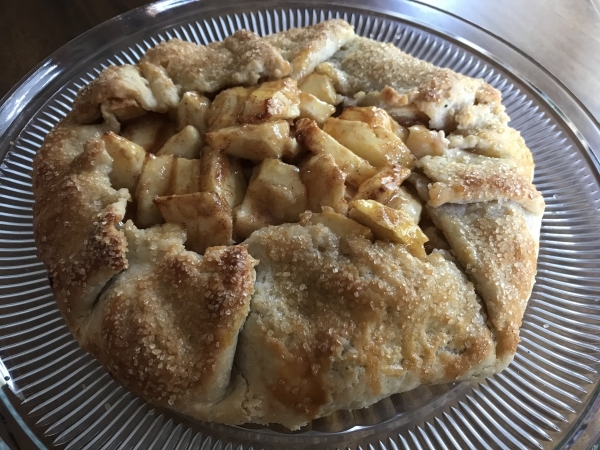BELLOWS FALLS — A sheet of pastry, some apples, and a few other ingredients, and you have a super quick and delicious dessert!
My mother Sylvia often used her extra pie dough to make a quick galette with whatever fruit, or even jam, she had on hand. This rustic, free-form tart is not only easier than a traditional two-crust pie, but it comes together in a flash and is lovely to look at as well.
And it doesn't need to look perfect. It's not supposed to!
Apple is perfect in a galette, and it can be enhanced with other fruits. Toss in a few fresh cranberries, local autumn raspberries, or even raisins.
The sprinkle of coarse turbinado sugar on the crust before the baking makes this dessert glisten, and it adds a nice crunch.
Use any apples you like, but try to use more than one variety for better flavor. Most recently, I used a Granny Smith, two Golden Delicious, and a Fortune to clear out my fruit bowl. The Granny is tart, the olden is sweet, and the Fortune has a strong apple flavor, so it was a nice balance.
The splash of Calvados is optional but highly recommended to reinforce the apple flavor. This apple brandy is my mother's secret ingredient, along with more vanilla than is normally used in a fruit pie.
I used my basic pastry crust, below, for this recipe, but if you have a favorite, that's the one you should use! You can even use puff pastry or prepared dough. I won't tell!
Apple Galette
Preheat your oven to 350 degrees.
In a large bowl, mix:
¶4 large apples, peeled, cored, and cut into thick slices
¶2 Tbsp. Calvados or other apple brandy
¶1 Tbsp. vanilla extract
¶{1/4} cup sugar
¶3 Tbsp. flour
¶{1/2} tsp. cinnamon
¶{1/2} tsp. allspice
¶Pinch of salt
Roll out on a floured surface:
¶1 basic pastry crust (recipe follows)
Lightly flour the board and rolling pin, and roll the pastry crust dough out gently from the middle, turning it a quarter turn every couple of strokes.
Mound the apple mixture in the center and dot with:
¶1 Tbsp. chilled butter, {1/4}-inch cut
Gently bring the dough up over the fruit, making little folds to hold it together as you keep the round shape.
In a small bowl, beat:
¶1 large egg
¶1 tsp. water
Brush this egg wash over the dough and sprinkle with:
¶Turbinado sugar
Bake for about 45 minutes on the middle rack, or until the pastry is golden brown and the apples are tender when pierced with a knife. Let cool completely before cutting.
Basic Pastry
This recipe makes two crusts, and you can freeze the extra. Have all your ingredients, even the flour, well-chilled before you start.
In a food processor fitted with a steel blade, combine:
¶3 cups pastry or all-purpose flour
¶1 tsp. salt
Pulse a few times to combine, then add:
¶{1/2} cup unsalted butter, cubed and well chilled
¶{1/2} cup shortening (or solid coconut oil, or use another {1/2} cup of butter), chilled
Pulse quickly six or seven times. The dough will look like coarse sand with some big clumps of butter in it. This is what you want.
In a liquid measuring cup with a pouring spout, add:
¶{1/2} cup ice water (remove ice cubes)
¶1 Tbsp. lemon juice or white vinegar
Drizzle almost all of the mixture over the dough and pulse again, quickly, six or seven times. Remove a little clump and squeeze it: if it sticks together easily, your dough is ready, even if it still looks unmixed. If it falls apart, add the rest of the water and pulse once or twice. The dough will still look craggy and unmixed.
Pour the whole thing out on a lightly floured counter and very gently press the dough together, bringing up the loose sides.
If you have hot hands, keep your warm fingers off the dough by placing it on a large sheet of plastic wrap, gathering up the sides, and pressing the edges into the dough.
Continue until the dough forms a mass. Cut in two, and gently form into discs.
Your dough should still have visible bits of butter throughout. As it heats up in the oven, the water in the butter will create steam, which will add to the flakiness.
Wrap the discs of dough and place them in the refrigerator for 30 minutes. This is an important step, as the gluten in the flour will need to relax and the flour will need to absorb the water.
You can freeze the surplus dough at this point.
